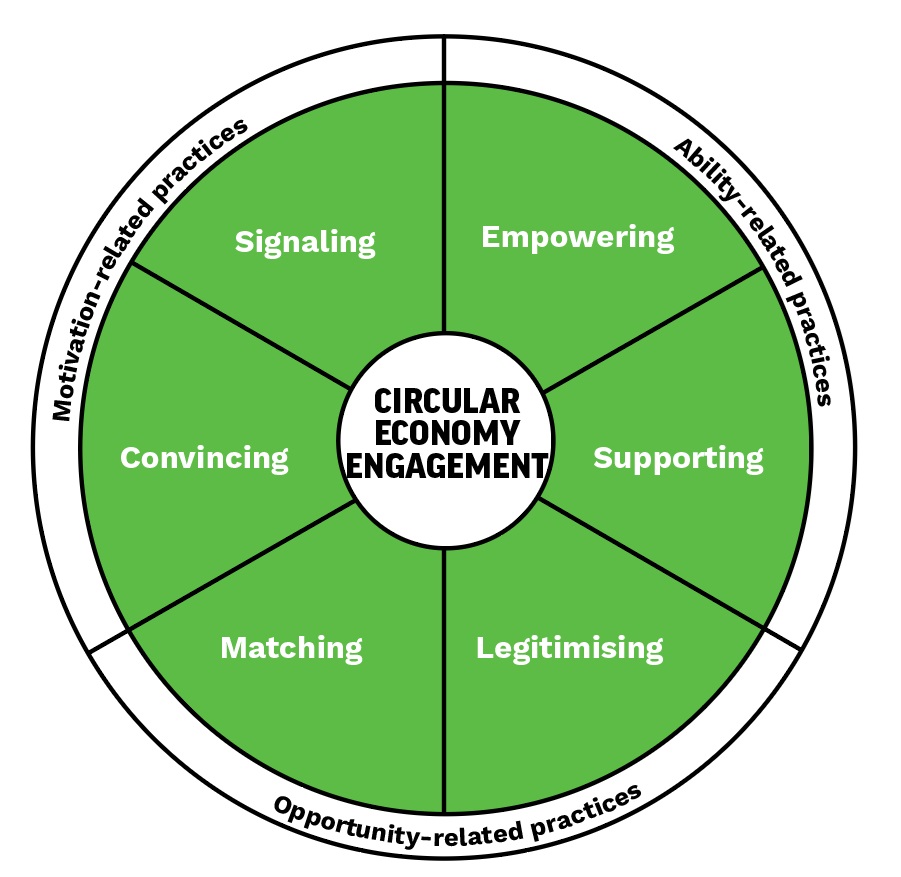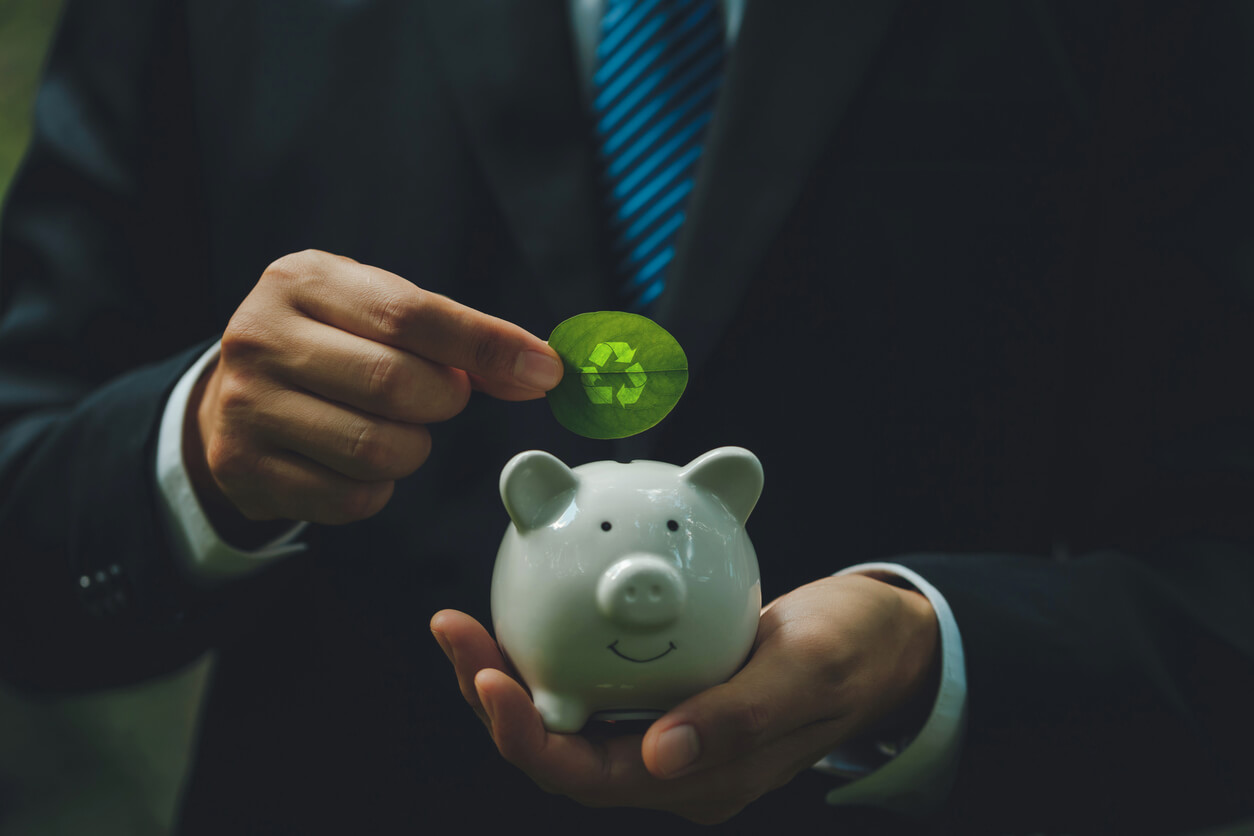By Arne De Keyser, Katrien Verleye, Néomie Raassens,
and Alex Alblas
Leading companies such as Philips, Renault, and IKEA are embracing circular business models to reduce environmental impact and promote sustainability. This article explores strategies for engaging stakeholders in the circular economy, and proposes effective practices for driving systemic change.
What do Philips, Renault, Solvay, Fairphone, H&M Group, IKEA, and Intesa Sanpaolo have in common? All these companies have committed to (partly) adopting circular business models oriented towards slowing down, narrowing, and / or closing resource loops. These actions are critical in reducing the burden on our finite natural resources and promoting a circular economy, which starkly contrasts with the prevailing linear “take-make-waste” model that leads to a rapid depletion of natural resources. In fact, according to the World Bank1, the current global demand for natural resources exceeds our planet’s regenerative capacity by a factor of 1.75.
By striving for enhanced resource efficiency through circular business models (see exhibit 1 for an overview of the three dominant models), companies can minimise their environmental impact and contribute to substantial economic growth. Indeed, a report by McKinsey and the Ellen MacArthur Foundation2 suggests an 83 per cent reduction in CO2 emissions across Europe by 2050 compared to 2012 levels and a potential 12 percentage point increase in GDP relative to non-circular growth. Altogether, this represents a $4.5 trillion opportunity3.
The current global demand for natural resources exceeds our planet’s regenerative capacity by a factor of 1.75.
Yet, the shift towards a circular economy is not progressing swiftly enough. Despite global discussions on the importance of circularity, the 2024 Circular Gap Report indicates that the share of secondary materials consumed globally has decreased from 9.1 per cent in 2018 to 7.2 per cent in 2023 — a 21 per cent drop in just five years4. This alarming trend raises a critical question: how can companies effectively engage their customers, partners, investors, and other stakeholders to embrace circular economy principles?
In a recent research paper5, we analysed academic work on circular and sustainable business models to better understand key success factors for engaging various stakeholders — companies, consumers, and governments — in the circular economy. We identified three key areas where actions can catalyse a circular and sustainable shift (see figure 1): (1) motivating stakeholders through signalling and convincing practices which support the case for circular business models; (2) creating opportunities for stakeholders through matching and legitimising practices which facilitate the adoption of circular business models; and (3) enabling stakeholders to fully embrace circular business models by supporting and empowering practices. By understanding and leveraging the proposed framework, managers can effectively navigate the complexities of circularity.
Fostering Motivation: Signalling and Convincing Practices
A combined strategy of signalling and convincing is vital to motivate different stakeholders to engage with circular business models. Signalling involves highlighting circular business models’ economic, environmental, and / or social benefits. As part of its ambition to transform into a circular business, IKEA started to sell second-hand furniture. Its website explains how these offerings, labelled “Re-Shop and Re-Use”, can help reduce waste6. Other signalling practices include sustainability certifications or reports like the EU Ecolabel and ESG reporting.
Figure 1. Circular economy engagement practices

Convincing happens when the spotlight is put on immediate, tangible measures and incentives for engaging with circular business models, such as discounts, tax breaks, or take-back initiatives. Patagonia, a circular economy pioneer that offers clothes made with recycled materials, transparently promotes its “Ironclad Guarantee”7. This measure assures customers that they can opt for a repair, replacement, or refund if they are dissatisfied with their products. Going even further, the company widely communicates that its profits are dedicated to environmental causes8, demonstrating a deep commitment to supporting the planet.
Creating Opportunities: Matching and Legitimising Practices
Being motivated does not suffice. Stakeholders also need to have the opportunity to engage circularly. To create such opportunities, companies need to establish and uphold matching and legitimising practices. Matching refers to fostering connections between various stakeholders to create synergies that facilitate the adoption of circular practices. The Circulars9, a well-known accelerator organisation, seeks to connect organisations prioritising circular innovation. Alternatively, circular partnerships may also be established directly. ArcelorMittal and Gestamp, for instance, signed an agreement to boost the circular levels of the automotive supply chain10. All of these reflect a collaborative arrangement where resource loops are slowed down, narrowed, or closed, reinforcing the circular economy.
Legitimising circular practices reflects the creation of an environment where circular business models can thrive and are accepted. While governments typically take a leading role in developing and launching regulations to incentivise circular practices (e.g., France’s anti-waste law to phase out single-use plastic packaging by 204011), companies themselves can also enact legitimising practices. Aldi12, for instance, sets concrete sustainability objectives for its suppliers. This allows the company to exert upstream influence and enhance the sustainability of its entire supply chain. In another way, Decathlon13 now offers resale and rental services alongside its traditional products. Doing this helps “normalise” a circular consumption model, especially when an incumbent player like Decathlon is pushing it, and aids toward a positive shift of consumers’ mindset to circular options.
Enhancing Abilities: Supporting and Empowering Practices

Finally, stakeholders also need to be capable of going circular. For this, it is crucial to implement supportive and empowering practices. Supporting other stakeholders to embrace circularity can be achieved by providing the necessary resources, such as infrastructure, expertise, and funding. Accenture14, for instance, supports and advises its clients on achieving better resource planning and utilisation, thereby contributing to circular and sustainability goals. Many big financial players provide companies with grants or loans to invest in circular initiatives. The European Investment Fund invested €50 million in Infinity Recycling’s Circular Plastics Fund to accelerate circularity in the plastics industry15, aiming to support the industrial and commercial scale-up of companies that provide advanced plastics recycling. Blackrock developed a circular economy fund of over $1 billion to invest in companies benefiting from or contributing to the circular economy16.
Given the detrimental impact of the current linear “take-make-waste” economic model, the transition to a circular economy becomes not just beneficial but essential.
Empowering other stakeholders involves the provision of capacity to engage with circular business models through education and training. This may encompass offering workshops or seminars on sustainable practices or developing online resources that guide stakeholders on how to get started with circular activities. This not only leads to the development of skills but also raises awareness about the importance and practicality of engaging in a circular economy. The Ellen MacArthur Foundation, for instance, contributes to the circular economy by offering an extensive array of free resources17. These resources, including educational videos, podcasts, and detailed case studies, are designed to enhance our understanding of the circular economy. By providing these tools, the foundation empowers people and companies worldwide to learn about and implement circular economy principles, reinforcing the global shift towards sustainability.
Engaging Actors is Key to Unlocking Circular Economy Success
Given the detrimental impact of the current linear “take-make-waste” economic model, the transition to a circular economy becomes not just beneficial but essential. However, the pace of this transition is slow, and progress towards achieving circular ambitions is limited. To catalyse a more systemic shift, it is critical that all relevant stakeholders — companies, citizens, and governments — implement a comprehensive set of practices that foster the circular economy and engage others around them to join. The shift towards a sustainable future requires a holistic approach in which signalling, convincing, matching, legitimising, supporting, and empowering practices are not isolated efforts.
Exhibit 1. Circular Business Model (CBM) Types

To effectively put these practices into action, companies (as well as other parties like governments, NGOs, etc.) can establish a robust monitoring system to track the implementation of each practice, determining which ones are short-term priorities and which require longer-term planning. While signalling and convincing efforts can often kick off immediately, legitimising initiatives may demand more time and strategic foresight. Moreover, it is crucial to clearly define roles and responsibilities for each practice. Marketing and sales teams may be well suited to leading signalling and convincing endeavours, while HR representatives may spearhead empowerment initiatives.
In sum, advancing towards a circular economy requires a collective and coordinated effort across all six practices. Integrating these practices into the fabric of our economic activities offers the best path forward for sustainable development. Through this comprehensive approach, we can hope to achieve the systemic change needed to sustain our planet’s resources for future generations.
About the Authors
 Arne De Keyser is a Professor of Marketing at EDHEC Business School in France. His research is focused on customer experience, new technologies and circular services.
Arne De Keyser is a Professor of Marketing at EDHEC Business School in France. His research is focused on customer experience, new technologies and circular services.
Katrien Verleye (Ghent University, Belgium)
Néomie Raassens (Eindhoven University of
Technology, the Netherlands),
Alex Alblas (Eindhoven University of Technology,
the Netherlands)
References
-
World Bank, “World Bank Releases Its First Report on the Circular Economy, Says Decoupling Growth from Resource Use in Europe Achievable,” World Bank Press Release, 6 December 2022, accessed 10 May 2024, https://www.worldbank.org/en/news/press-release/2022/12/06/world-bank-releases-its-first-report-on-the-circular-economy-says-decoupling-growth-from-resource-use-in-europe-achievab.
-
Ellen MacArthur Foundation, “Growth within: A Circular Economy Vision for a Competitive Europe,” accessed 8 May 2024, https://emf.thirdlight.com/file/24/_A-BkCs_h7gRYB_Am9L_JfbYWF/Growth%20within%3A%20a%20circular%20economy%20vision%20for%20a%20competitive%20Europe.pdf.
-
UNEP, “New UNEP Report Lights the Way for Financial Institutions to Shift More Capital Towards Sustainability,” UNEP Press Release, accessed 12 May 2024, https://www.unep.org/news-and-stories/press-release/new-unep-report-lights-way-financial-institutions-shift-more.
-
Circle Economy, “The Circularity Gap Report 2024: A Circular Economy to Live Within the Safe Limits of the Planet,” accessed 10 May 2024, https://www.circularity-gap.world/2024#download.
-
Verleye, K., De Keyser, A., Raassens, N., Alblas, A. A., Lit, F. C., & Huijben, J. C. C. M. (2024). “Pushing Forward the Transition to a Circular Economy by Adopting an Actor Engagement Lens.” Journal of Service Research, 27(1), 69-88.
-
IKEA, “Circular Hub,” accessed 5 May 2024, https://www.ikea.com/gb/en/offers/circular-hub-pub2eab7840.
-
Patagonia, “Ironclad Guarantee,” accessed 15 May 2024, https://eu.patagonia.com/be/en/ironclad-guarantee.html.
-
Patagonia, “Our Ownership,” accessed 15 May 2024, https://eu.patagonia.com/be/en/ownership/.
-
https://thecirculars.org/
-
ArcelorMittal, “ArcelorMittal and Gestamp Sign Circularity Agreement to Boost Sustainability of Automotive Supply Chain,” accessed 15 May 2024, https://corporate.arcelormittal.com/media/news-articles/arcelormittal-and-gestamp-sign-circularity-agreement-to-boost-sustainability-of-automotive-supply-chain.
-
Arlene Karidis, “France to Ban Plastic Packaging by 2040 with Other Crackdowns in Store,” Waste360, accessed 24 May 2024, https://www.waste360.com/plastics/france-to-ban-plastic-packaging-by-2040-with-other-crackdowns-in-store.
-
Aldi, “SDGs and Supply Chain,” accessed 12 May 2024, https://www.aldi.nl/sustainability-report/2017/highlights/sdgs-and-supply-chain.html.
-
Forclaz, “Rental and Second-Hand,” accessed 18 May 2024, https://www.forclaz.co.uk/rental-second-hand.
-
“Top 10 Brands Embracing the Circular Economy in 2023,” Sustainability Magazine, accessed 24 May 2024, https://sustainabilitymag.com/top10/top-10-brands-embracing-the-circular-economy-in-2023.
-
European Investment Fund, “InvestEU: EIF Invests €50 Million to Support Circular Plastics,” accessed 2 May 2024, https://www.eif.org/what_we_do/guarantees/news/2023/investeu-eif-invests-50-million-to-support-circular-plastics.htm.
-
BlackRock, “BGF Circular Economy Fund,” accessed 10 May 2024, https://www.blackrock.com/hk/en/literature/fund-in-focus/bgf-circular-economy-fund-flyer-hk-en.pdf.
-
Ellen MacArthur Foundation, “Examples of the Circular Economy in Action,” accessed 15 May 2024, https://www.ellenmacarthurfoundation.org/topics/circular-economy-introduction/examples
-
Fehrer, J. A. & Wieland, H. (2021). “A Systemic Logic for Circular Business Models.” Journal of Business Research, 125, 609-620.






































